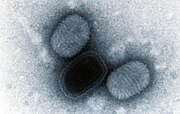Molluscum contagiosum virus
| Molluscum contagiosum virus | |
|---|---|
 |
|
| EM of Molluscum contagiosum viruses | |
| Virus classification | |
| Group: | Group I (dsDNA) |
| Family: | Poxviridae |
| Genus: | Molluscipoxvirus |
| Species: | Molluscum contagiosum virus |
The Molluscum contagiosum virus (MCV) is a species of virus in the poxvirus family, which causes the disease Molluscum contagiosum in humans. Virions have a complex structure and is consistent with the structure of the poxvirus family: a surface membrane, a core, and lateral bodies. Virus may be contained within inclusion bodies and mature by budding through the membrane of the host cell giving rise to a large amount of viral shedding in a short period of time. Approximate measurements of the virus are 200 nm in diameter, 320 nm in length and 100 nm in height.
Diagnosis is made on the clinical appearance; the virus cannot routinely be cultured. The diagnosis can be confirmed by excisional biopsy. There are 4 types of MCV, MCV-1 to -4. MCV-1 is the most prevalent in human infections, and MCV-2 seen usually in adults and often sexually transmitted.Polymerase chain reaction techniques are being developed to help confirm lesions as being caused by MCV, and distinguish between strains.
The genome is a non-segmented single molecule of linear, double-stranded DNA of 180000–200000 nucleotides. It is covalently linked at both ends and contain redundant, repeating sequences at both ends. 160 putative genes have been identified.
A poxvirus causes a very similar disease in equids (horses and donkeys). DNA studies suggest that this virus and the human virus are very closely related.
...
Wikipedia
